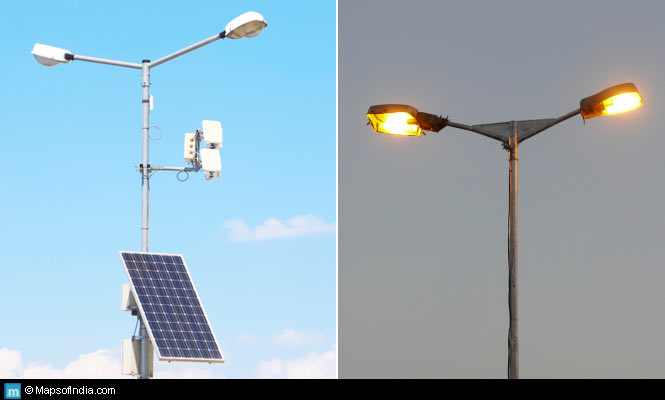 The BJP-led NDA government is all set to present the Budget for FY 2015-16. All eyes will be on the government for direction on future policy for sustaining growth.
The BJP-led NDA government is all set to present the Budget for FY 2015-16. All eyes will be on the government for direction on future policy for sustaining growth.
Irrespective of what the Budget highlights or omits, one challenge that will continue to concern the nation is the rising demand for power. The gap between demand and supply of power will determine the extent to which the government will be able to meet its development objective. The key is to not just increase investment and enhance power generation, which is a prime need anyways, but invest in more efficient power distribution and optimize power consumption through use of efficient technology.
An important component of power consumption worldwide is street lighting. India is no different. Global trends in street lighting show that 18-38% of the total energy bill goes towards street lighting and therefore this is one domain that needs major attention if we look at improving efficiency of power consumption with an objective of saving energy.
India has a total installed capacity of generating 255681.46 MW, as on 31 Dec 2014, as per CEA, Ministry of Power. Of this, Coal based units generate 154170.89 MW, Gas based units – 22971.25 MW, Diesel – 1199.75 MW, Nuclear – 4780 MW, Hydro – 40867.43 MW and Renewable energy -31692.14 MW.
The sector-wise share of installed capacity is: State owned units – 37%, Private units -36% and Central units – 27%.
Under the 12th Plan, the total capacity addition for power generation was 88537 MW, against this, the actual capacity added till December 2014 was 49058. 22 MW. It clearly suggests that the government has no choice but to take up the challenge of improving power distribution and consumption, as earnestly as increasing power generation capacity.
Power tariff and distribution to end consumer is a state subject and therefore the responsibility and initiative for improving power distribution and consumption lies with the state governments and the active utilities in the state. While power tariffs and consumer priorities have been a matter of much debate, the need for implementing power saving measures as a means for reducing energy cost has never been greater.
At the state level, most of the State Electricity Boards are reeling under massive losses on account of a combination of subsidy and under-recoveries. The National Tariff Policy of 2006 stipulates that the State Electricity Regulatory Commission (SERC) fix tariff within +/- 20% of the cost of supply. Unfortunately, most states fail to meet this guideline. As a result, the power sector in most states are in a financial mess.
This proves a major handicap when it comes to investing in more energy efficient power distribution equipment and latest power metering and monitoring systems. The one sector that needs urgent attention is street lighting.
Poor Condition of Street Lighting
In most cities, the street lights are installed and maintained by municipalities. Most urban and semi-urban cities and towns are still using a combination of fluorescent, CFL, high pressure sodium lamps or metal halide bulbs, which are not designed to meet area-wise lighting needs. Very little study or planning has gone into the illuminance required in different areas of streets, to address the needs of pedestrians and vehicular traffic alike. For instance, the lighting needs of vehicular traffic in high speed zones are different from low-speed high traffic zones. Likewise, lighting needs in road crossings are different from secondary roads. Then again, the lighting requirements of an area with vehicular traffic will vary from that of an area with high pedestrian traffic.
A one-size-fits-all approach to street lighting results in inefficient deployment of power resources and ends up in wasteful use of electricity that could have been better utilized elsewhere. Street light planning is not just about luminosity but also the ‘height’ of the lighting mast, which in turn varies based on the requirements of that particular area. Due to a lack of ‘area-wise’ study, standard tenders are issued on a ‘city-wise’ basis, leading to high operational cost incurred on street lighting. Very often, one notices that the street lights stay on well past sunrise. This is because the lights are switched off based on a predecided time rather than lighting needs, which vary based on season and location of the city. There is a need for devising a well thought out way to prevent wastage of electricity. Perhaps, the government can think of implementing Automatic Street Light Control System using LDR (Light Dependent Resistor), which automatically switches off lights when sunlight fall on it.
Poor maintenance of street lights is another problem faced by most citizens, leaving large areas without adequate lighting. The municipalities are hard pressed for funds and it is the citizens who have to face the brunt.
Initiatives by Government and Other Agencies
India’s need for power will keep increasing as the country moves up the development ladder and this opens up a massive opportunity for the energy efficiency sector. The market potential in India for this sector alone is estimated at Rs 74,000 crores. Presently, Energy Service Companies (ESCO) cover less than 5% of the market and are restricted on account of regulatory, institutional and financial constraints.
In 2008, the National Mission for Enhanced Energy Efficiency (NMEEE) was launched, as part of eight National Missions of the Government. By 2014-15, NMEEE is targeting savings of 23 Mtoe of fuel savings in petroleum, coal and gas products. The carbon dioxide emission reduction is expected to be 98.55 Mt per annum.
The government has set up Energy Efficiency Services Limited (EESL) in 2010, a joint venture between NTPC Limited, PFC, REC and POWERGRID, to promote energy efficiency projects in both government and private sector. Currently, EESL is working closely with Jharkhand State Electricity Board, Chamundeshwari Electricity Supply Corporation, and the Bangalore Electricity Supply Corporation for a variety of Distribution Energy Efficiency Projects.
The Bureau of Energy Efficiency (BEE) is laying down standards for all stakeholders of street lighting, which involves use of efficient lamp technologies, optimization of pole and placement, efficient light distribution that balances the need for light and visibility.
The Energy and Resources Institute (TERI) is also doing pioneering work in sustainable living with ecological balance and energy efficiency. They have been advocating conversion to more efficient energy technologies and advising government and private sector bodies on a variety of sustainable measures.
New Technologies Available
Prime Minister Narendra Modi is pushing for smart cities in India with a target of putting up at least a 100 such cities, which will have at least a million residents. The estimated investment will exceed Rs. 35,000 crores. In order to keep operational costs down, one sector that needs to be efficiently designed is the electricity generation, distribution and monitoring. In the context of street lighting, the government needs to give special focus on solar power generation (on grid and off grid), use of LED bulbs in street lighting and smart grid monitoring.
Today, solar power generation has become more viable with recent developments in efficient Photovoltaic Modules (PV). This has made possible the use of independent street lights that have minimal-to-no dependency on grid-based electric supply. When used with extremely low-power-consuming but high on luminosity LED bulbs, the potential power saved from grid-based supply is significant. With volume production, the per capita cost of both the solar panel and LED bulb will come down further, making the adoption even more viable.
The potential can be gauged by the fact that a city like Chennai has 2,14,008 street lights maintained by the Corporation of Chennai. Of these, 84,664 use 70 watt Sodium Vapour lamps, 49,420 use 40 watt tube light, 42,250 use 250 watt Sodium Vapour lamps. The total energy consumption in Chennai, on account of the above, is 19 MW. It comes at a cost of Rs 200 lakhs per month.
Consider the advantages of usingLED lamps instead of a High PressureSodium Vapour lamp (SVL). The LED offers 50-80% energy saving over SVL, has a life of over 50,000 hours – working 10 hours a day for 13 years which is more than 5-10 times the life of a SVL or mercury lamp and offers far higher luminosity over a SVL. A switchover to LED is not only financially favourable but also environmentally beneficial.
Recently, BEST has decided to convert the SVL-based street lights of the iconic Marine Drive in South Mumbai with LED. This is likely to result in significant energy savings, while enhancing the overall luminosity. Several other cities are now coming forward and making investments in converting existing street lighting to LED. That is the right way to go.
It is also imperative for the state governments to further incentivise municipalities and similar institutions to convert to LED, preferably solar-based LED street lights, if India has to continue to make energy available for other priority areas.





